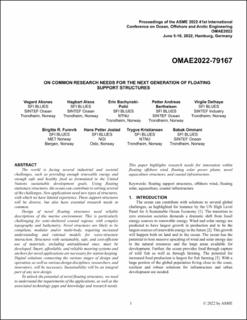| dc.description.abstract | The world is facing several industrial and societal challenges, such as providing enough renewable energy and enough safe and healthy food as formulated in the United Nations sustainable development goals. Using floating stationary structures, the ocean can contribute to solving several of the challenges. New applications need new types of structures, with which we have limited experience. These support structures will be diverse, but also have essential research needs in common.
Design of novel floating structures need reliable descriptions of the marine environment. This is particularly challenging for semi-sheltered coastal regions, with complex topography and bathymetry. Novel structures are likely to be compliant, modular and/or multi-body, requiring increased understanding and rational models for wave-structure interaction. Structures with sustainable, safe, and cost-efficient use of materials, including untraditional ones, must be developed. Smart, affordable, and reliable mooring systems and anchors for novel applications are necessary for station keeping. Digital solutions connecting the various stages of design and operation, as well as various design disciplines, researchers, and innovators, will be necessary. Sustainability will be an integral part of any new design.
To unlock the potential of novel floating structures, we need to understand the requirements of the applications, as well as the associated technology gaps and knowledge and research needs. This paper highlights research needs for innovation within floating offshore wind, floating solar power plants, novel aquaculture structures, and coastal infrastructure. | en_US |
